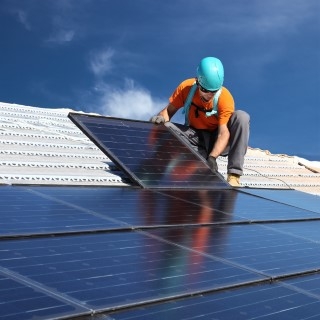
Indian solar tariffs fall 25% in three months
Module prices are sharply going down.
Last week, Solar Energy Corporation of India’s (SECI) 750MW utility scale auction in Bhadla solar park saw tariffs fall to a new astounding low of INR 2.44 (US¢ 3.79)/ kWh, according to Bridge to India.
This comes after much brouhaha over tariffs falling to INR 3.25/ kWh (levelized) and INR 3.15/ kWh in Rewa, Madhya Pradesh and Kadapa, Andhra Pradesh respectively in the last three months.
At the same time last year, tariffs for most tenders were observed around INR 4.60 (US¢ 7.1)/kWh mark. What explains a tariff reduction of almost 50% in one year or 25% in just three months?
Here's more from Bridge to India:
Module prices fell by 30% in the last one year and developers seem to be counting on a similar fall next year. Competition amongst developers has intensified due to easing up of new tender announcements and greater private sector interest.
The industry is evolving at break-neck speed and catching policy makers, DISCOMs and even developers unawares. Winning bidders for the two tenders in Bhadla include ACME (INR 2.44/kWh, 200 MW), Softbank (INR 2.45/kWh, 300 MW), Phelan (INR 2.62/kWh, 50 MW), Avaada (INR 2.62/kWh, 100 MW) and Softbank (INR 2.63/kWh, 100 MW).
A key obvious contributor to falling tariffs is sharp reduction in module prices, down almost 30% in the last one year. And developers seem to be pricing in similar price reduction going forward – at about US ¢ 23/Wp in the next 10 months. Although module industry dynamics remain benign, it seems a very bold call to price such reduction in base case.
Fall in Indian debt cost by up to 1.00% per annum over the last year (equivalent to tariff reduction of approximately INR 0.10/ kWh), higher irradiation in Bhadla (INR 0.15/ kWh), lower solar park charges (INR 0.05/ kWh) and stronger Rupee go some way in explaining the tariff reduction. Another relevant factor is improvement in SECI’s credit rating. The participating bidders’ list in Bhadla tender shows that both Indian and international developers are growing comfortable with SECI offtake risk.
But the other very important factor is increased competition amongst developers due to fewer new tenders and complete lack of pipeline visibility over the next year. We have maintained for some time that the Indian solar market is getting overheated and that these tariffs are unsustainable.
Falling tariffs are a double-edged sword for the sector. They make solar power more attractive for consumers but are also making investors and lenders jittery. In the near term, they are also creating uncertainty in the minds of policy makers and creating new risks for older projects auctioned at 2-3x higher tariffs.























 Advertise
Advertise








